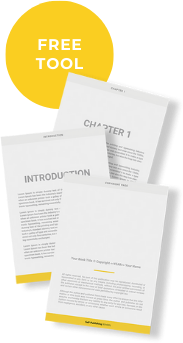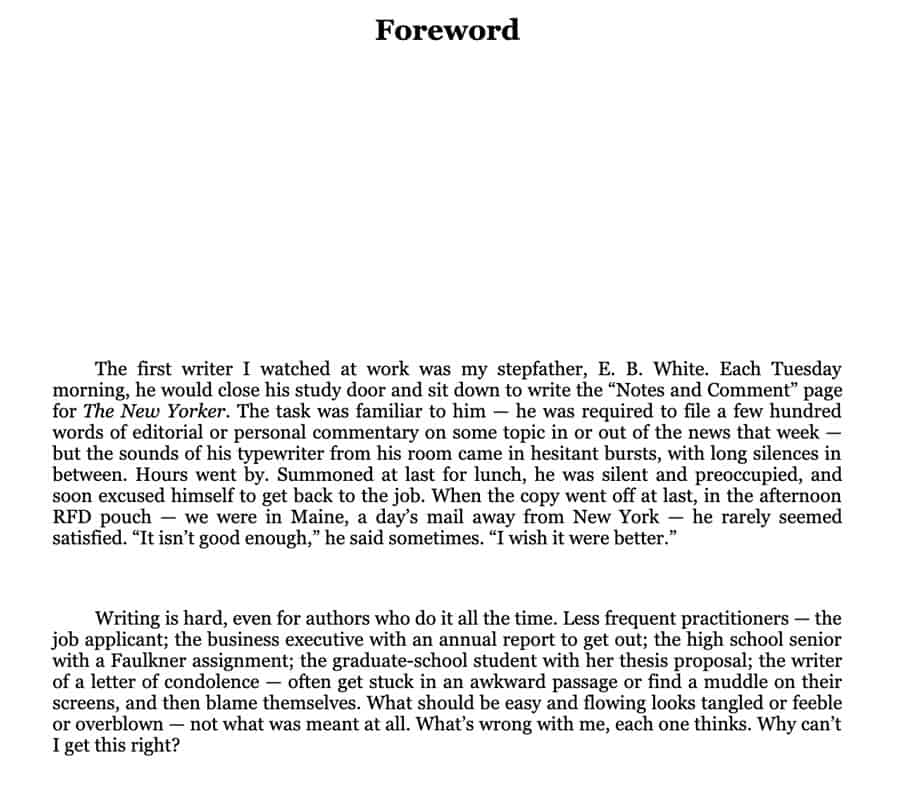If you’re confused about what a foreword is, you’re not alone.
A new writer, especially someone looking to self-publish a book, has a steep learning curve ahead of them.
There are so many new skills to learn—building and managing a book launch team, finding a book cover design, making Amazon Marketing Services work for you, et cetera—and new vocabulary words to go along with them.
Here are the questions we answer:
- What is a foreword
- How to write a foreword
- Do I need a foreword for my book?
- Who should write a foreword?
- What should be included?
- What’s the difference between a foreword and introduction?
- What’s the difference between a foreword and a preface?
- What’s the difference between a foreword and a prologue?
Pro Tip: Sign up for a free book outline below – for fiction or non-fiction – to be delivered to your email inbox as you continue to read through this article. Your book outline will be fully-formatted, including key pages like book foreword page, copyright page, acknowledgement page, and more!


Book Outline Generator
Choose your Fiction or Nonfiction book type below to get your free chapter by chapter outline!
Book Outline Generator
Enter your details below and get your pre-formatted outline in your inbox and start writing today!
CONGRATULATIONS
Thanks for submitting! Check your email for your book outline template.
In the meantime, check out our Book Outline Challenge.

What is a foreword?
A foreword is a piece of writing that serves to introduce the reader to the author and the book, usually written by someone who is not the author or an editor of the book. They can also serve as a sort of endorsement for the book.
If the author does write this section, it might be to explain how the book came to be, or their connection between the work and themselves—like Stephen King often does for his novels.
It always goes at the very front of the book (with one exception, which I’ll get into below), and it’s rarely more than a couple of pages long.
You may see it written with either lowercase Roman numerals or typical Arabic numerals, or without any page numbering whatsoever. That is between you and your book formatter.
How to write a foreword
You’re pretty sure you’ve seen forewords in books before, or maybe your favorite classic piece of literature has one in the front. You’ve got a book now, or you’re well on your way to finishing it.
Do you need one too? Do you need front matter at all?
Then again, maybe you’re not new, and you’ve been around the proverbial block enough times to know your way around. Maybe you’ve gained enough recognition to be asked to write a foreword for someone else’s work.
And maybe you’re someone looking to write one for someone else’s book and have no idea where to start.
Here’s how to write a foreword:
- Understand what the author is looking for
- Know the tone and style of the book
- Start with a list of what you want to cover in the foreword
- Make sure to mention your credibility
- Tie your own experience back into the worth of the book
- Get feedback from others and the author
- Make any necessary changes to comply with what the author is looking for
- Be honest about the book and its impact
Do I need a foreword for my book?
Now that we know what a foreword is, it’s time to get into the nitty-gritty of whether your book really needs one. This is what you’ve been waiting for!
The first thing to note is that it’s certainly not necessary.
Plenty of books don’t have one, and never have them added on. Unless your book needs the elaboration and context provided, you won’t miss it.
What you really need to consider is whether you’re writing fiction or nonfiction.
A nonfiction book is far more likely to need one rather than a novel, especially if the topic is dense or interesting, or the author has passed on. Again, Stephen King does tend to produce them for his own fiction novels but this is seen far less in authors who aren’t as established.
For example, the fourth edition of The Elements of Style has a great one by Roger Angell arguing that the guide is just as relevant today as it was the day Strunk and White turned the manuscript into the publisher.

But if you are writing fiction, are you covering a period of history, or some other topic, in depth?
It may be helpful if the reader needs a bit of background knowledge to sink their teeth into your book. Charles Todd wrote one explaining just who was the titular character of Agatha Christie’s Hercule Poirot: The Complete Short Stories.
It’s also not uncommon for works of great literary renown to have one added onto the original manuscript, or added as a way of explaining the difference between the current edition and past editions.
Alice L. George’s in the 150th-anniversary edition of Little Women by Louisa May Alcott was written to illustrate why the book is so beloved all these years later.
Who should write a foreword?
It could be written by several people, but not by just anyone.
If you’re of the opinion that your work needs one, approach an expert in the topic of the book or one of your peers in your field, especially if this person is well-known.
This lends the book social proof.
Unless you have something especially noteworthy to say, it’s probably best not to write your own book’s. You may want to write a preface instead.
That being said, if you’ve established yourself as an expert in your field, you may be asked to write a foreword for someone else.
What should be included in a foreword?
If you’ve been invited to write one, congratulations! What an honor, and what an impressive accomplishment to add to your resumé!
Of course, every foreword will have needs as unique as the text that comes after, but here are some ideas for what you could include should you need to write one:
- Your relationship to the author (if you are or were contemporaries)
- How the author’s work affected you personally
- Your opinion of the book, its protagonist, and/or theme
- The book or author’s historical impact
- Differences between the current and past editions of the book (if applicable)
It’s also important when writing one, to strike the same tone as the rest of the book.

Avoid writing a witty, humorous foreword if the book is more serious, and vice-versa.
You don’t want the writing styles to clash, or you risk jarring the reader when they turn the page.
What’s the difference between a foreword and an introduction?
The introduction is reserved for a book of non-fiction. It can be used to explain the content, but they can also be used to summarize the work.
The introduction is sometimes comprised of everything that comes before the bulk of the text, meaning the foreword would be nestled within the introduction.
Other times, the introduction is a separate section written by the author themselves.
What’s the difference between a foreword and a preface?
If you’re looking to write something like an introductory statement to your own book, you may want to write a preface.
In a preface, you can include what your aim was in taking on the project and thank the people in your life who helped to make the book a reality.
Unlike the focus of this guide, prefaces are always written by the author, and they’re not signed. If your work happens to include both, the foreword comes first.
What’s the difference between a foreword and a prologue?
A prologue is always written for fiction, and it takes place within your story’s world.
Forewords never take place within your story’s world, unless you’re writing a fictional forward by one of your characters. You might do this if you’re writing as a fictitious person a lá Daniel Handler.
If your work happens to include both a prologue and a foreword, again, the foreword comes first.
And again, a prologue isn’t signed. (You can probably guess why!)
Forewords can be an important part of your book
Whether or not to include one in your book is—as is most of the art of writing—a matter of personal preference, but not preference alone. Consider what your particular work calls for.
Only you can make that call.
Trust yourself that you’ll make the right one.
Want a book outline template WITH a foreword inside?
Grab your fiction or non-fiction book outline template below!


Book Outline Generator
Choose your Fiction or Nonfiction book type below to get your free chapter by chapter outline!
Book Outline Generator
Enter your details below and get your pre-formatted outline in your inbox and start writing today!
CONGRATULATIONS
Thanks for submitting! Check your email for your book outline template.
In the meantime, check out our Book Outline Challenge.
